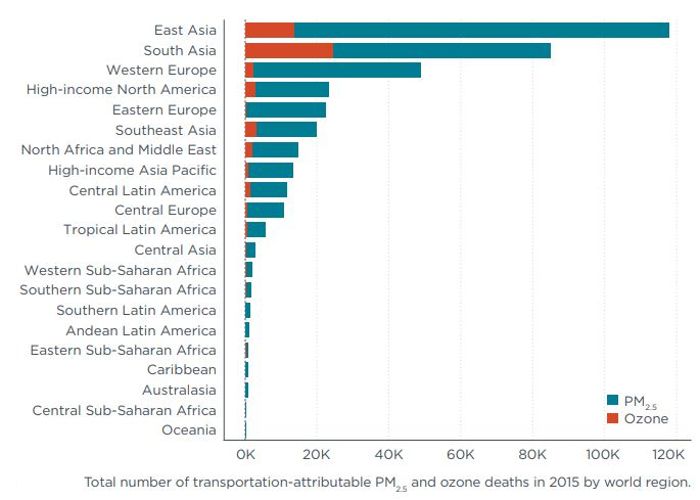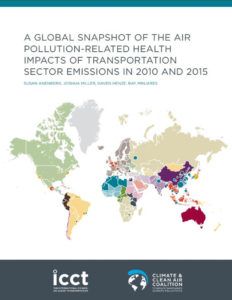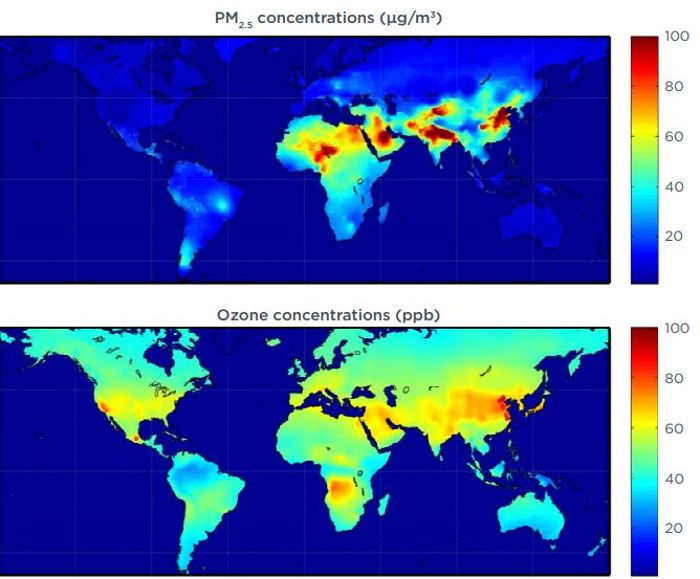A new study provides the most detailed picture available to date of the global, regional and local health impacts attributable to emissions from four transportation subsectors: on-road diesel vehicles; other on-road vehicles; shipping; and off-road mobile engines, such as agricultural and construction equipment.
Authored by researchers from the International Council on Clean Transportation (ICCT), George Washington University’s Milken Institute School of Public Health, and the University of Colorado at Boulder, the new study links state-of-the-art vehicle emissions, air pollution and epidemiological models to estimate health impacts at the global, regional, national and local levels in 2010 and 2015. The study estimates that vehicle tailpipe emissions were linked to ~361,000 premature deaths from ambient PM2.5 (fine particulate matter) and ozone (O3 trioxygen) worldwide in 2010 and ~385,000 in 2015. An estimated 70% of these impacts occurred in the four largest vehicle markets in 2015: China, India, the European Union, and the USA. The global cost of these transportation-attributable health impacts in 2010 and 2015 was approximately US$1tn.

Exhaust from on-road diesel vehicles was responsible for nearly half of the impacts (~181,000 premature deaths) worldwide, and fully two-thirds in India, France, Germany, and Italy. The global health burden of on-road diesel vehicles, including the PM2.5 and ozone impacts of all tailpipe emissions, is 68% higher than previously estimated for diesel NOx emissions, because it includes the effects of tailpipe PM2.5. In addition to estimated health effects on global, regional and national scales, the study also evaluated the impacts in 100 major urban areas worldwide. The number of transportation-attributable deaths per 100,000 population in London and Paris are approximately two to three times higher than the global average.
 Ambient air pollution is the leading environmental health risk factor worldwide, contributing to 3.4 million premature deaths annually from heart and lung diseases and diabetes, according to the Global Burden of Disease (GBD) study 2017. Previous studies had estimated the global health burden of emissions from all transportation sources, and from subsectors such as land transportation and shipping, in 2005, 2010 and 2014, but none had evaluated health impacts at the same level of granularity as this study. The study assessed health impacts of transportation emissions using the GBD 2017 methods, which consider the impacts of ambient PM2.5 and ozone exposure on incidence of six disease categories.
Ambient air pollution is the leading environmental health risk factor worldwide, contributing to 3.4 million premature deaths annually from heart and lung diseases and diabetes, according to the Global Burden of Disease (GBD) study 2017. Previous studies had estimated the global health burden of emissions from all transportation sources, and from subsectors such as land transportation and shipping, in 2005, 2010 and 2014, but none had evaluated health impacts at the same level of granularity as this study. The study assessed health impacts of transportation emissions using the GBD 2017 methods, which consider the impacts of ambient PM2.5 and ozone exposure on incidence of six disease categories.
The study’s authors say the conclusions are conservative. Recent evidence indicates that the health response to PM2.5 pollution may be greater at high concentrations than previously estimated, and that air pollution may be associated with chronic kidney disease, pre-term birth and other birth outcomes, and cognitive decline. Consideration of these impacts would likely increase the estimate of health impacts from vehicle exhaust emissions.
“The high public health burden of diesel vehicles in Europe underscores the need for world-class emissions standards to be accompanied by robust compliance and enforcement,” said Joshua Miller, co-author of the study and a senior researcher at the ICCT. “The long lifetime of vehicles and equipment and the increasing health burden in regions without adequate protections stress the urgency to introduce world-class standards, develop compliance programs, and adopt in-use measures that accelerate the replacement of high-emitting vehicles.”





